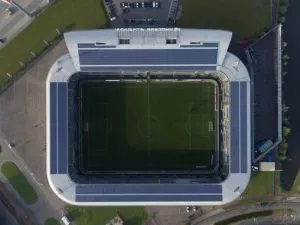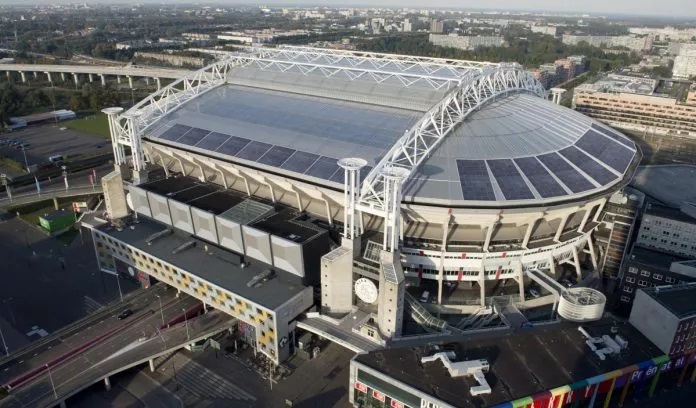The 2018 World Cup is still on everyone’s lips. However, the topic of discussions includes not only the brightest players and their goals, but also a number of innovations that relate directly to the stadiums.
Holland became the brightest example in the world of how you can turn a stadium into a kind of power plant. At the same time, the main function of the facility remained the same – the holding of sports (and not only) events.
 Starting in 2013, the Dutch managed to install solar panels in five major stadiums. It should be note that the generated energy is enough to provide electricity to 1375 households. Such innovations are carriy out within the framework of the government program to reduce the dependence of Holland on imported raw materials.
Starting in 2013, the Dutch managed to install solar panels in five major stadiums. It should be note that the generated energy is enough to provide electricity to 1375 households. Such innovations are carriy out within the framework of the government program to reduce the dependence of Holland on imported raw materials.
Nordlease Stadion has become a pioneer in this program. 1092 panels are installed on the territory of the facility. The total capacity is 240 thousand kilowatt-hours. The stadium is able to satisfy the energy needs of 70 houses.
The first batch of solar modules on the roof of the stadium was install in 2013. Then their number was 531. It is important to note that the first modules were install for the personal account of local residents. The essence of this program is that anyone can buy solar panels in any quantity and install them on the roof of the stadium. Naturally, he does not personally conduct the installation. Its task is only to make investments, and the rest of the work falls on the shoulders of the project organizers. What amount of energy is generate by his “investment”, so much he reduces his bills for electricity.
The popularity of the project began to gain momentum and within a year, it became clear that we would have to add more panels. The second batch of modules was 561 pieces.
The largest project remains Amsterdam ArenA. The Dutch do not plan to stop on their laurels and intend to equip other stadiums of the country with solar panels.
AFAS Stadion includes 1725 solar modules. The capacity of the facility is about 250,000 kilowatt-hours. The stadium can provide electricity to 125 homes.
 When the project was completed and ready for work, it became the largest station for generating solar energy on a city scale. In addition, this despite the fact that the roof of a single stand was reserved for the installation of panels. The choice fell precisely on this podium not just, because there are the most optimal conditions for the maximum productivity of the modules.
When the project was completed and ready for work, it became the largest station for generating solar energy on a city scale. In addition, this despite the fact that the roof of a single stand was reserved for the installation of panels. The choice fell precisely on this podium not just, because there are the most optimal conditions for the maximum productivity of the modules.
Rat Verlegh Stadion has 2600 solar modules on the roof and boasts a capacity of 655,000 kilowatt-hours. The number of households provided by electricity is 260.
The stadium is one component of a large-scale project to install solar panels in the city. The organizers plan to install 27.5 thousand modules.
On the roof of the Kyocera Stadion is installed 2900 solar panels. Its capacity is 600 thousand kilowatt-hours. About two hundred homes can receive energy from the facility.
In addition to the fact that each of these objects provides itself with energy, they also cover the energy needs of a considerable number of houses. Holland has become a global example of how to implement alternative technologies in the usual places and get obvious benefits without any harm to the environment.


